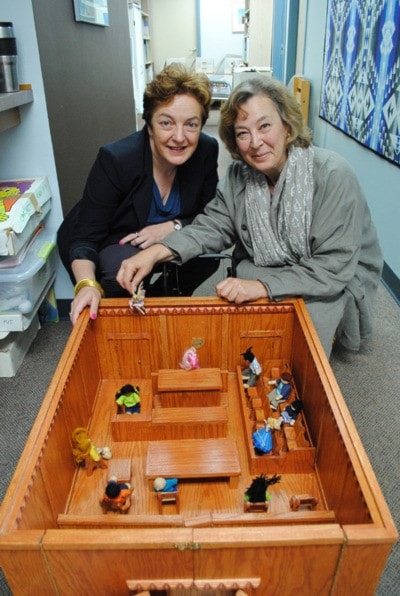The Mary Manning Centre clears path for children dealing with sexual assault cases
In the wooden toy courtroom, My Little Pony plays judge. A pixie statue is the court secretary, and Cinderella sits in the jury. Playschool characters fill the seats, while a fabric doll acts as lawyer and one little figurine with pigtails testifies.
It’s scary enough going into court as a child without knowing what’s waiting for you, but the Mary Manning Centre, Child Abuse Prevention and Counselling Society of Greater Victoria, is doing what it can to help children face some of the hardest times in their lives.
“There are still so many people out there who need our services but don’t know we even exist,” says Jessica Van der Veen, vice chair of the centre’s board of directors. “We see about 200 new clients each year, but the statistics are showing us that that number should be threefold.”
In an effort to increase their service mandates, the centre is hosting a special workshop this week that focuses on one of the most underrepresented threats to youth: cyber safety. The workshop will happen at St. John the Divine (1611 Quadra) right before the centre’s annual general meeting on Tuesday from 4 p.m. to 6:30 p.m., which will also be open to the public. A $10 suggested donation allows parents, child care workers and those interested information on talking to youth about online safety, looking for trouble signs, prevention measures, as well as refreshments and guest speakers.
Christine Willes is a director on the centre’s board, and is a survivor of teen sexual abuse. While she says vast improvements have been made in the system since she was a teenager, she believes we do still underestimate sociopaths.
“The threat used to be the stranger with candy, but now we know that’s just not true. Child abuse and sexual assault can come from family, from friends,” says Willes. “But now the internet is that new stranger with candy, and these children can be like sitting ducks to emotional manipulation … This is a threat that thrives on silence.”
While the centre is funded in part by the government and in part by community donations, resources are still few. The small centre, which has approximately 20 staff and has been in its Cook Street office location for eight years, is packed with file folders, kids toys and waiting chairs, and is still waiting to find a permanent space that will be big enough to serve clientele. Despite recent numbers from Statistics Canada, which say one in four girls and one in six boys will experience sexual assault before age 18, getting the word out about services remains one of the centre’s biggest challenges.
“If there was a headline for this story, it would be, ‘Newsflash: few resources put into child abuse.’ When I joined the board four years ago, I was surprised how little is out there to serve children in need of help,” says Van der Veen. “You’d think it would be a top priority, but it’s one that people still have so much trouble even talking about.”
Van der Veen says the centre receives more disclosures of incidents every time a worker is sent out to make school visits, but often the group lacks the resources to cover wide swaths. And whereas it’s up to governmental social workers to make the call on whether or not a family stays together, the centre’s role is to provide children first — and families second — assistance in dealing with everything from reporting incidents, to accessing counselling, to dealing with the court system, to relearning a feeling of safety.
“These kids do so well. They bounce back, they’re resilient and the sooner we get to them, the sooner they can dust themselves off and get back to their lives,” says Van der Veen. “It is harder the longer they wait, and if you don’t catch them when the child is ready to talk, then you lose them. Children should not have to wait.”
Willes says that while it’s easy to underestimate the serious effect trauma can have on an individual, seeking treatment and talking about the issues will accelerate the healing process.
“Even if you’ve never experienced abuse yourself, you’d have to live in a cave to have it not affect you,” says Willes. “These individuals grow up, and it can change how you look at the world. It affects us all, and getting informed and mainstreaming the discussion can fight this.”
As for parents who may be concerned but don’t know what to do, there are signs to look for — like sudden changes in behavior, appetite, grades, or acting out sexually with other children — but the centre is there to help.
“There are still a lot of stigmas we have to deal with in 2011, but what we try to help people understand is that these kids are not damaged goods. These are our children, they’ve survived a bump in the road, and they will recover,” says Van der Veen. “Big things happen to little lives. We have to be here to help each other.” M
For more information, contact the Mary Manning Centre via marymanning.com. For immediate counselling service or assistance, call the Kids Help Phone at 1-800-668-6868.
